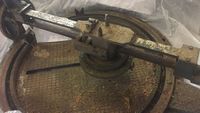Dumaresq
<video id="ZQTBfvJH_xc" height="300" width="400" frame="false" position="right"/>
A Dumaresq (sometimes the initial D is capitalised, though the practice subsided) is an mechanical analog fire control instrument helpful in related the relative motion of one's own ship and a target ship to the corresponding range rate and speed-across. It was designed and patented by Lieutenant John Saumarez Dumaresq between 1902 and 1904.[1]
There were a considerable number of dumaresq Marks, but all answered to the same underlying geometric principles. Initially, they were manufactured by Elliott Brothers, but a Mark VIII instrument salvaged from the lost St. Vincent Class battleship H.M.S. Vanguard bears manufacturer's marks of the Fidelity Engineering Company, Limited of London.[2]
Geometric Principle
A dumaresq functions by mechanically implementing a flexible means of illustrating the geometry of two independently moving ships to quickly perceive the other ship's motion along and across the line of bearing, these values being called the range rate and the speed-across, respectively. Specifically, it permitted a user to subtract the motion vector of your own ship from that of a target ship to yield the target's relative motion vector which could then be projected onto a Cartesian coordinate graph oriented along the line of bearing, permitting the range rate and speed-across to be read off as a coordinate pair.
Users commonly set up a dumaresq in this manner:
- set their own ship's speed and heading
- set the target ship's speed and heading (by estimation)
- rotate a pair of coordinate axes along the line of bearing to the target
- read the range rate off one axis of the graph and the speed across off the other
However, the dumaresq was not a modern computer which used a given set of inputs to a given set of outputs. It was wholly indifferent to which of the variables it represented in its workings were inputs and which were outputs. Altering one variable by rotating a knob or by positioning a slider caused other variables to change to continually satisfy the relationship between two ships moving around and the range rate and speed-across their relative motion would imply. This meant that the sequence of use described above which derives range rate and speed-across from the speed and heading of both vessels and the target bearing could be worked flipped on its head to find the enemy speed and heading from a given range rate and speed-across. This was called a "cross-cut".
Cross-Cut
When making a cross-cut, a dumaresq operator would manually move the indicator stem expressing the difference of own ship's and target ship's motion and permitting the enemy heading ring and speed slider to re-orient and slip as needed to follow these demands. Upon placing the indicator at the range rate and speed-across he thought proper, the dumaresq would then indicate the enemy speed and heading that would be implied by your hypothesis of range rate and speed across (own ship's speed and heading and the target bearing being held unchanged in this case). The cross-cut demonstrates a fundamental charm of an analogue calculator: if their design is amenable, inputs and outputs have no meaning, as the devices model relationships between data and don't regard one or another as having an inherent primacy.
Steps to make a cross-cut on a dumaresq:
- set their own ship's speed and heading
- rotate a pair of coordinate axes along the line of bearing to the target
- drag the relative velocity indicator stem to the estimated range rate and speed-across
- observe the enemy speed and heading which are then indicated
Mark I
This model was marked for range rates according to the original Royal Navy practice, not in yards per minute but in time interval required to change the range by 50 yards. The design was later adapted by adding a rifle-like peep sight to the dial plate so it could be rotated to match the line of bearing by finding the target in the sight from an aloft position. Presumably in such a mode of use, the dumaresq would have its "own course" arm left aligned with own ship's keep, making all headings and bearings on the instrument relative ones. Some found their way onto the new Dreadnought.[3]
Mark II
An enlarged model which also saw service in Dreadnought.[4] It was considered obsolete by 1920.[5]
Mark II*
Presumably, this is also larger than the Mark I, but it is not clear how it differs from the Mark II. It was said to be identical to the Mark III.[6] It was considered obsolete by 1920.[7]
Mark III

This dumaresq had a fixed fore-and-aft bar for own heading, though an inner ring marked with compass headings would be rotated. Common practice kept it locked in place so its markings would become relative bearings. Likewise, the enemy heading ring had a compass wing that could be rotated, but was usually locked down to match the own heading bar. The result of this was that the enemy heading would be expressed as a relative heading.[9]
It did not feature any gearing to maintain enemy heading as own heading changed; the user had to rotate the enemy heading ring in retrograde to keep its absolute heading the same. In 1913, it had been suggested that a pointer be added, pivoted at the center of the dial, to help in maintaining this.[10]
The dial plate retained the rifle peep sights. In 1915, it was referred to as an "old pattern", essentially the same as a Mark II*.[11] This model was still in service in 1920, but noted as "practically obsolete."[12]
Mark III*
The particulars of this model yet await my discovery.
Mark IV
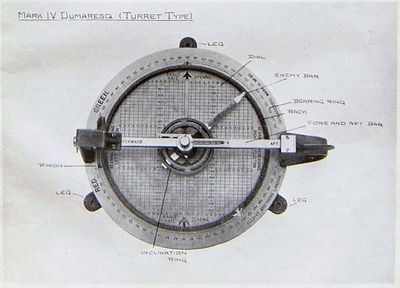
This model, also known as the turret dumaresq was optimized for use in turrets, and therefore it was essential to permit its fore-and-aft bar to swivel to remain parallel with the keel of the ship as the turret it was fitted in trained. The fixed angle, then, was the line of bearing on the dial plate which always faced the front of the turret. The markings for aligning the fore-and-aft bar were arranged such that the operator indicated the turret's relative training angle, not own ship's heading. The enemy heading ring was geared to rotate as the bearing was set with the consequence that the operator spun the enemy heading bar to an indicated inclination (rather than heading) — convenient![14]
It required the user to re-set the enemy heading when own ship altered course.[15]
Mark V

This model was used in spotting and control towers that did not revolve,[17] and in the conning towers of light cruisers.[18] From this, we may infer that the own heading arm was fixed or generally kept locked in line with own keel and that bearings were relative. It was smaller than the Mark III, presumably to avoid cluttering the busy platform on which it was sited. It retained the rifle sight characteristic of dumaresqs intended for standalone use in positions that can directly observe the enemy.[19]
Mark VI
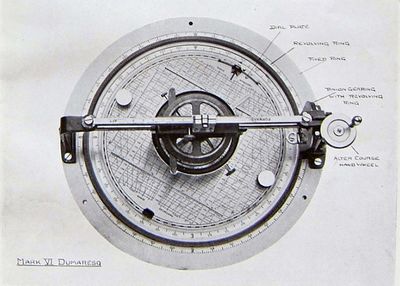
In 1915, this was described as the latest model for use in control tops.[21]
The chief difference between the Mark III and the Mark VI is that the setting of the enemy's inclination is kept on automatically during a turn of own ship.
In this instrument there is a revolving ring between the dial plate and the fixed ring, and this revolving ring is geared to the holder carrying the enemy bar. It is also geared to the dial plate.
Any movement of the revolving ring is directly transmitted to the enemy bar, which will move by the same angular amount in the same direction as the revolving ring.
The dial plate can be moved independently of the revolving ring by means of two small pinions.
On the dial plate of the Mark VI are screwed 4 thin brass strips. Two of these strips are graduated in degrees of change of bearing at 10,000 yards, the other two are plain. Two celluloid strips are supplied with the instrument, and these strips can be placed so as to slide between the brass strips.
If one of these celluloid strips is placed at the degree of rate of change of bearing at the range of the target and the other is placed at the rate in use, the point of intersection of the black lines on the celluloid strips will be the actual point over which the pointer-of-the-enemy bar should be, and thus the course and speed of the enemy can be checked.
This method can only be used in ships fitted with a gyroscopic compass for taking bearings.[22]
[TO BE CONTINUED - TONE]
"To set the instrument: set the speed of own ship and enemy's speed and inclination in the usual manner. Align sights of the dial plate on the enemy by means of the small pinions, the worm shaft being connected up. The rate, deflection and bearing can then be read off. If own ship alters course, the bearing must be kept on by turning the small hand-wheel on the vertical shaft, or by unclutching the worm-shaft and turning the intermediate ring. The latter method is quicker than using the hand-wheel. During the alteration, the revolving ring being geared to the enemy bar will revolve the ring and preserve its inclination to the line of bearing."[23]
Mark VI*
This is the variant which was used by the Mark III Dreyer Table. It permitted a worm drive from a gyrocompass receiver to continually apply changes in own heading.
Notice the considerable gearing used to permit a flexible shaft which comes in from the top to apply gyrocompass influence to maintain the heading of our own ship. But it gets nastier. Because the Mark VI has a range clock beneath it, and this could not be made to revolve with the dial plate, the plate was fixed and this required a pretty clumsy ballet of opposing motions (I think... it hurts to think about it).
On the lower right is the handle to set the range clock, whose indicating pipper on the slotted dial plate is bluish in this rendering. To its left is a manual knob for adjusting the bearing (it has a spring-loaded clutch to disengage the bearing clock). Not shown below the bearing clock speed gauge at the bottom is the handle which sets its speed.
Mark VII

Similar to a Mark VI, this model was for use in revolving control towers. A rack on the control tower applied the bearing as the tower trained.[25]
"Similar to the Mark VI, with the addition of an extra ring, graduated from 0 to 180 on either side of the fore and aft line mounted outside the original ring on the enemy bar carrier as fitted in the Mark VI. This ring facilitated the setting of the angle between keels, but enemy inclination is estimated rerelative to the line of bearing, or line of fire, in modern practice, and all later dumaresqs are graduated accordingly, In other respects the operation of the instrument is similar to the Mark VI, except that for change of bearing dial is revolved by two small knobs, no pinions being fitted for this purpose."[26]
Mark VII*
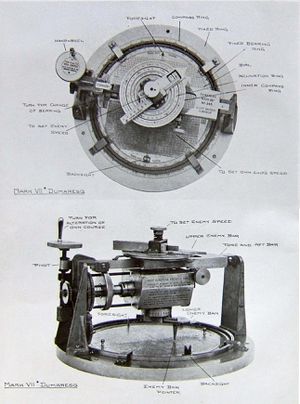
- Three rings are fitted on the enemy bar carrier: one graduated for inclination to line of fire; one for inclination to own fore and aft line; and one as a compass ring.
- A double enemy bar is fitted, the upper portion to be used for setting speed and inclination and the lower portion carrying the pointer for reading off rate and deflection.
- The dial plate is fitted with gearing driven by a milled head under the fore and aft bar.
These were used, along with Repeaters underneath, one on each broadside, to provide the relative bearings to the T.S.. By 1915, these had been combined with Evershed transmitters with binoculars, permitting the same device to indicate the target as well as provide bearings.[29][30]
Mark VIII
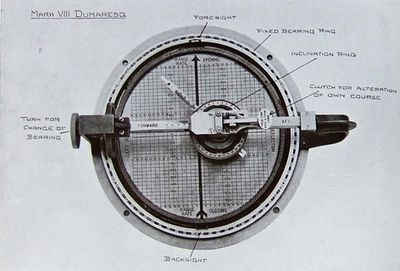
In 1923, Cdr. John Bernard Hughes was thanked for his zeal and ingenuity in connection with the design of the Mark VIII Dumaresq. It is not clear whether this thanks was tardy or concerned some refinements to the device, which is documented at least as early as 1920.[32]
- Salvaged Mark VIII Dumaresq at Stromness Museum
"No outer compass ring is fitted on this instrument, and only one ring, graduated for inclination to line of bearing, is fitted on the enemy bar carrier. This ring is geared to the dial plate so that it is always kept with its zero radius parallel to the line of bearing. The enemy bar is normally free of this inclination ring and does not revolve with it, so that for ordinary alteration of bearing the "angle between keels" is preserved; a pedal clutch permits clutching the enemy bar to the inclination ring when own ship alters course, thus preserving enemy inclination to line of bearing. The clutch consists of two serrated rings, one on the underside of the inclination ring and the other in the upper side of the enemy bar. Depressing the pedal raises the enemy bar until the two rings mesh, when enemy bar will be locked to, and will revolve with, the inclination ring."[33]
The Mark VIII continued to be used in installations aloft, as indicated by its appearance in a post-World War II handbook.[34]
Some, but not all, of these devices featured a small cylindrical graph across the line of bearing, which could be spun up to an indication of the target range. The curves etched on the cylinder would relate the dumaresq deflection being indicated on the dial plate to a Gun Deflection.
Extant Specimen
On 6 February, 2023 the editor, Tony Lovell, acquired an instrument of this type, sold to him from a person in India. The lever to be pressed while changing course had been bent, but the device was repaired in the hands of a talented gunsmith. This dumaresq features the optional gun deflection cylinder, and a cursory inspection hints that this device may have supported the fire of 6-in guns, perhaps on light cruiser H.I.M.S. Delhi or Mysore.
Mark IX
Mark X
Mark XI
The extremely Spartan Mark XI was probably the simplest dumaresq ever built. It was suitable to armed merchant ships and likely saw service throughout World War II[35]. It was so reductionist in its design that the speed of own ship was fixed at 12 knots. Moreover, the dial plate did not even have markings for taking range rate — it indicated a speed-across only. The speed-across obtained was intended to be used directly as the gun deflection, as the vessels mounting such a dumaresq were expected to fight at such short ranges that times-of-flight were roughly proportional to range and so speed-across was a fair estimate of deflection.
Mark XII
The Mark XII was very similar to the Mark XI in design and intended deployment, and only a little fancier; its dial plate did indicate a range rate[36]. This implies that it was probably used in concert with a Vickers Range Clock.
Electrical Dumaresq
The electrical dumaresq was an extremely elaborate version (with minor variations) created for use in Mark IV, Mark IV* and Mark V Dreyer tables. It contained electrical hunting gear that would, when an Auto/Hand clutch was set to Auto, automatically transfer range rate to the range clock and to carry Dumaresq Deflection to the Change of Bearing Gear, providing tighter automation than in Mark III tables where these were effected by hand on occasion when the need for such adjustment was realized.
The electrical dumaresq was the zenith of ambition and automation of the dumaresq-based Dreyer tables, but it takes but a glance to see that it also starkly illustrates the general unsuitability of the dumaresq to integration within a well-designed system of fire control: it is plug ugly, resembling an early wheat combine. It must have been fairly self-evident to the designers of successors to the Dreyer table that the journeyman rate instrument of the Royal Navy must be put out to pasture.
The best source for the electrical dumaresq is the booklet issued in May 1916, Captain F. C. Dreyer's Fire Control Apparatus, Mark IV.[38]
As in the Mark VI* dumaresq of the Mark III tables, the dial plate was fixed, indicating a line of bearing always facing to the right. The inner edge of the fixed dial plate had bearings (dial "A") marked 0 to 180, red and green. A double pointer "C" on the own heading bar indicated against this scale the relative target bearing angle. A second dial "B" indicated in degrees 0-360 the heading of own ship via pointer "C", and also the compass bearing of the enemy by the ever-rightward-directed arrow "T" on the bearing plate. Conveniently, pointer "C" also indicated the relative target bearing against dial "A".
The bearing angle was ordinarily driven by the bearing clock but could be manually set by lifting up the clutched Hand Wheel "A.A." on the axis from the bearing motor, and turning it to turn compass ring "B" and the outer ring which carried the fore-and-aft bar. After adjusting, Hand Wheel "A.A." would be pushed back down to once again engage the bearing clock.
Dial "D", riding atop slide bars and intended to be kept under the enemy pipper by hand or the automated electrical means provided permitted the enemy inclination to the line of bearing to be read in degrees left or right, 0-180, from pointer "V".
High on the centrework, Dial "E" was revolved by gearing to maintain its 0-360 degrees agreeing with dial "B" below. Pointer "G" moved with the enemy bar and read enemy compass heading against "E". Just below "E" was Dial "F", fixed to own heading bar, against which Pointer "G"'s second pipper indicated relative angle between keels, 0-180 red and green. Pointer "H" thrust upward to indicate own ship's speed against scale "J" which permitted a maximum of 30 knots, adjustable by means of Knobs "K.A." which conveniently could be themselves be read against Scales "K" or adjusted from either side of own ship's heading bar, thus ensuring that no configuration of the dumaresq could obstruct their use.
Enemy speeds of 0-30 knots could be read on Scales "L" and Pointers "M" (printed on both sides of enemy bar). Thumb Levers "L.A" located at each end of the enemy bar had to be depressed before altering enemy speed or heading.
Pointers and Wires "O" and "P" permitted range rate set on the clock and the dumaresq deflection being used by the bearing clock to be conveniently read against Scales "Q" and "R" marked in the proper units. A movable Pointer "S" could be positioned wherever desired along the range rate scale to assist in "spotting the rate".[39]
As you will note, there is no clear "enemy pipper" on this device as in prior dumaresqs. The Pointer "V" seems as if it would be this, but it is only to be used in reading against Dial "D". Rather, the ugly little stem jutting down to the centre of Dial "D" is functionally the enemy pipper. This difference is what made the electrical dumaresq truly unique, as it permitted the position of the enemy pipper to be automatically followed by electrical motors which served to move the cross-dial assemblies "P" and "O" as needed when the pipper strayed from the center of Dial "D", which had contact plates on its face. The stem had 4 probes that reached down to the centre of Dial "D", where 5 electrical contact plates were situated. When the dial was centered, the 4 probes surrounded a central contact pad. When the dial was not centered, an opposing pair (or both opposing pairs) of probes would contact the center plate and one of the four peripheral plates, completing a circuit to prompt the control motor to drive the "O" and "P" bars in the proper direction to align the plate under the pipper and thus break the circuits.
The dumaresq's automatic following mode was engaged or disengaged by moving Clutch Lever "C.A." (which is nearly off Figure 4 to the right) between positions "Auto" and "Hand". When in "Auto", the control motors worked to keep Dial "D" centered under the enemy pipper. When thrown into "Hand", manual adjustment of speed across and range rate by use of hand wheels ("H.A."? and "Q.A.", left and right, respectively) on the front of the dumaresq became possible, moving Wires and Pointers "O" and "P".
The final charm of the electrical dumaresq's centrework is that it contained (at least by 1918) commutators to signal the enemy speed and inclination in use to repeater instruments in the GCT and aloft.[40] By 1930, the electrical transmitters for conveying the enemy speed and inclination to these repeaters was seen as extraneous and were generally removed.[41]
Obsolescence
The dumaresq was first eclipsed from service when its integrated application within the Dreyer Fire Control Table was not succeeded by an appearance with its heirs and cousins such as the Royal Navy's Admiralty Fire Control Table or the American Navy's Ford Rangekeeper. Both these evolutionary paths of development features "rate solvers" similar in mechanical design to the one found in the Argo Clocks. The rate solvers in the Argo clocks were much more compact and intrinsically supported the Argo's inventive visual display which clearly represented the relationship of own ship, target ship, and the relative bearing. The functionality was largely the same between these two designs, but the dumaresq looked and felt clumsy relative to the alternative.
The dumaresq enjoyed a longer reign in aloft positions for moderately equipped ships which paired simple dumaresqs with a standalone range clock. The Mark VIII, XI and XII were prominent examples, finding representation in documents created after World War II[42].
See Also
- Brooks, John (2005). Dreadnought Gunnery and the Battle of Jutland: The Question of Fire Control. Oxon: Routledge. ISBN 0714657026. (on Amazon.com and Amazon.co.uk).
- Admiralty, Gunnery Branch (1946). Handbook On Minor Fire Control Instruments 1946. B.R. 1534. Copy at Admiralty Library, Portsmouth, United Kingdom. A partial web equivalent is available at H.N.S.A..
- EU/SV Anzeiger
- Wind Dumaresq
Footnotes
- ↑ Brooks. Dreadnought Gunnery. p. 42.
- ↑ BBC Story.
- ↑ Brooks. Dreadnought Gunnery. pp. 42, 43.
- ↑ Brooks. Dreadnought Gunnery. pp. 42,43.
- ↑ Schleihauf. "The Dumaresq and the Dreyer". Part I. p. 8.
- ↑ Manual of Gunnery, Vol. III., 1915., p. 171.
- ↑ Schleihauf. "The Dumaresq and the Dreyer". Part I. p. 8.
- ↑ Manual of Gunnery (Volume III) for His Majesty's Fleet, 1920. Plate 1.
- ↑ Schleihauf. "The Dumaresq and the Dreyer". Part I. pp. 7-8.
- ↑ Manual of Gunnery (Volume III) for His Majesty's Fleet, 1915. p. 172. (G. O. 7 of 1 January, 1913).
- ↑ Manual of Gunnery (Volume III) for His Majesty's Fleet, 1915. p. 171.
- ↑ Schleihauf. "The Dumaresq and the Dreyer". Part I. pp. 7-8.
- ↑ Manual of Gunnery (Volume III) for His Majesty's Fleet, 1920. Plate 1.
- ↑ Schleihauf. "The Dumaresq and the Dreyer". Part I. pp. 8, 11.
- ↑ Manual of Gunnery, Vol. III., 1915., p. 174.
- ↑ Manual of Gunnery (Volume III) for His Majesty's Fleet, 1920. Plate 2.
- ↑ Schleihauf. "The Dumaresq and the Dreyer". Part I. p. 8.
- ↑ Manual of Gunnery, Vol. III., 1915., p. 171.
- ↑ Schleihauf. "The Dumaresq and the Dreyer". Part I. p. 11.
- ↑ Manual of Gunnery (Volume III) for His Majesty's Fleet, 1920. Plate 2.
- ↑ Manual of Gunnery, Vol. III., 1915., p. 171.
- ↑ Manual of Gunnery, Vol. III., 1915., p. 172.
- ↑ Schleihauf. "The Dumaresq and the Dreyer". Part I. p. 12.
- ↑ Manual of Gunnery (Volume III) for His Majesty's Fleet, 1920. Plate 3.
- ↑ Manual of Gunnery, Vol. III., 1915., pp. 171, 174.
- ↑ Schleihauf. "The Dumaresq and the Dreyer". Part I. p. 13.
- ↑ Manual of Gunnery (Volume III) for His Majesty's Fleet, 1920. Plate 4.
- ↑ Schleihauf. "The Dumaresq and the Dreyer". Part I. p. 13.
- ↑ Brooks. Dreadnought Gunnery. p. 170.
- ↑ Captain F. C. Dreyer's Fire Control Apparatus, Mark IV, Sheet 19A.
- ↑ Manual of Gunnery (Volume III) for His Majesty's Fleet, 1920. Plate 6.
- ↑ Hughes Service Record. The National Archives. ADM 196/51/180. f. 181.
- ↑ Schleihauf. "The Dumaresq and the Dreyer". Part I. p. 15.
- ↑ B.R. 1534 (1), Handbook on Minor Fire Control Instruments
- ↑ B.R. 1534 (2), Handbook on Minor Fire Control Instruments
- ↑ B.R. 1534 (3), Handbook on Minor Fire Control Instruments
- ↑ Admiralty. Captain F. C. Dreyer's Fire Control Apparatus, Mark IV, Figure 4.
- ↑ Admiralty. Captain F. C. Dreyer's Fire Control Apparatus, Mark IV, Sheets 25-31, Figure 4.
- ↑ Editor must see what is meant by this.
- ↑ Admiralty. Dreyer Table Handbook, 1918, p. 76, Plates 25 and 33.
- ↑ Admiralty. Pamphlet on the Mark IV* Dreyer Table, 1930, p. 11.
- ↑ B.R. 1534 (1-3), Handbook on Minor Fire Control Instruments

